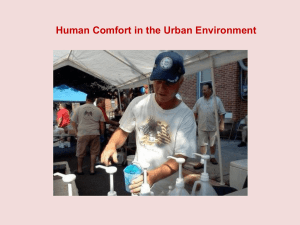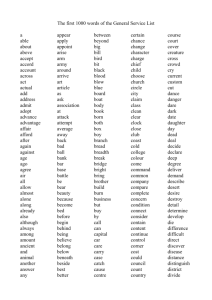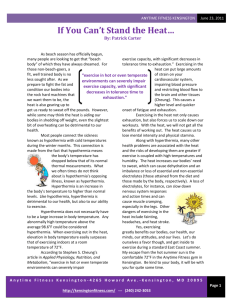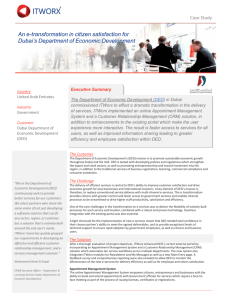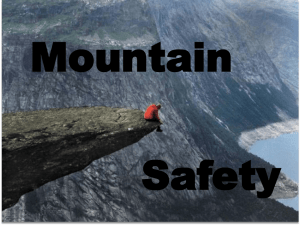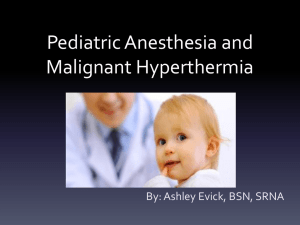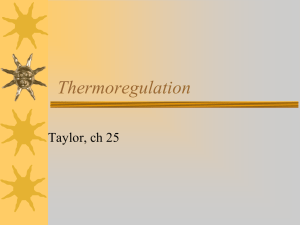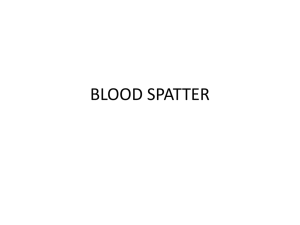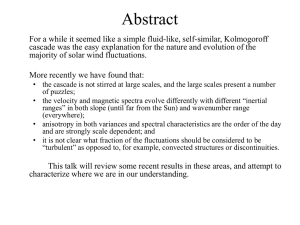Human Comfort - Cal State LA
advertisement
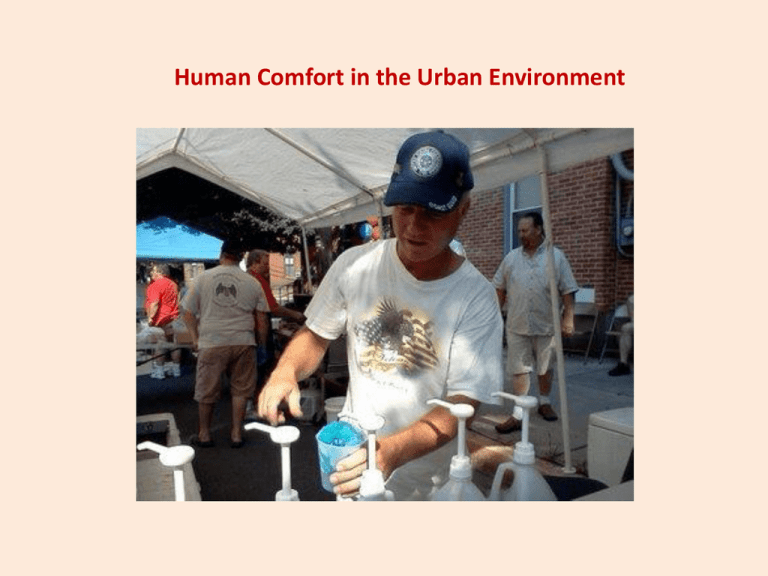
Human Comfort in the Urban Environment Solar loading impact on human thermal comfort M + Qn + C – LE = 0 Metabolic Rates for various activities The metabolic rate, or human body heat or power production, is often measured in the unit "Met". The metabolic rate of a relaxed seated person is one (1) Met, where 1 Met = 58 W/m2 (356 Btu/hr) The mean surface area, the Du-Bois area, of the human body is approximately 1.8 m2 (19.4 ft2). The total metabolic heat for a mean body can be calculated by multiplying with the area. The total heat from a relaxed seated person with mean surface area would be 58 W/m2 x 1.8 m2 = 104 W (356 Btu/hr) Activity W/m2 W1) Bt u/ Me hr t 1) Reclining Sleepimng 46 83 282 0.8 Seated relaxed 58 104 356 1.0 Standing at rest 70 126 430 1.2 Sedentary activity (office, dwelling, school, laboratory) 70 126 430 1.2 Car driving 80 144 491 1.4 Graphic profession Book Binder 85 153 522 1.5 93 167 571 1.6 Teacher 95 171 583 1.6 Domestic work shaving, washing and dressing 100 180 614 1.7 Walking on the level, 2 km/h 110 198 675 Standing, light activity (shopping, laboratory, light industry) 1.9 Running http://www.shapesense.com/fitnessexercise/calculators/resting-metabolic-rate-calculator.aspx 8-9 Activity Human Metabolic Rate (W/m2) (Met) Laying down 46 0.8 Sitting, relaxed 58 1.0 Standing, relaxed 70 1.2 Sitting activity (office work, school etc.) 70 1.2 Standing activity (shop, laboratory etc.) 93 1.6 Moving activity (house work, working at machines etc.) 116 2.0 Harder activity (hard work at machines, work shops etc. ) 165 2.8 Clothing and human comfort The insulation of clothes are often measured in the unit "Clo", where 1 Clo = 0.155 m2K/W Clo = 0 - corresponds to a naked person Clo = 1 - corresponds to the insulating value of clothing needed to maintain a person in comfort sitting at rest in a room at 21 ℃ (70 ℉) with air movement of 0.1 m/s and humidity less than 50% - typically a person wearing a business suit http://www.engineeringtoolbox.com/clo-clothing-thermal-insulation-d_732.html http://www.engineeringtoolbox.com/metabolism-clothing-activity-d_117.html Heat Discomfort Zone Maximum recommended work load Temperature Relative Humidity (%) oF oC 30 40 60 80 80 27 Very Heavy Very Heavy Very Heavy Heavy 90 32 Very Heavy Heavy Moderate Light Moderate Light Not recommen ded Moderate Light Not recommen ded Not recommen ded Light Not recommen ded Not recommen ded Not recommen ded 100 110 120 38 43 49 Heavy Heart rate, energy expenditure Body Energy Expenditur e (watts) Work Duration Restriction (hours) 70 - 175 none Effort Level Typical Tasks Heart Rate Elevation (beats per minute) Light riding bicycle at 10 km/h, canning paint, raking leaves, making drawings, machining light objects, sewing by hand 0 - 35 Moderate building brick wall, cleaning boiler, planing softwood, sheet-metal 35 - 55 working, soldering, using screwdrivers, walking on level 175 - 260 >2 Heavy digging trenches, using sledgehammer, stoking furnace, metal grinding, walking up 5% gradient 55 - 75 260 - 420 < 1 to 2 Very Heavy shoveling sand, using jackhammer, stacking concrete blocks, stone masonry, climbing normal stairs 75 - 90 420 - 700 < 1 to 2 Extremely Heavy sawing wood, climbing vertical ladder > 90 > 700 < 0.25 to 0.3 Heat Index in degrees Fahrenheit The heat index can be calculated as tHI = -42.379 + 2.04901523 t + 10.14333127 φ - 0.22475541 t φ - 0.00683783 t2 - 0.05481717 φ2 + 0.00122874 t2 φ + 0.00085282 t φ2 - 0.00000199 (T φ)2 where tHI = heat index (oF) t = air temperature (oF) (t > 57oF) φ = relative humidity (%) (1) Caution - Fatigue is possible with prolonged exposure and/or physical activity 2) Extreme Caution - Sunstroke, heat cramps and heat exhaustion are possible with prolonged exposure and/or physical activity 3) Danger - Sunstroke, heat cramps and heat exhaustion are likely. Heat stroke is possible with prolonged exposure and/or physical activity 4) Extreme Danger - Heatstroke/sunstroke is highly likely with continued exposure Wind Chill Index - Wind Velocity km/h and degrees Celsius The "Chilled" air temperature can also be expressed as a function of wind velocity and ambient air temperature as twC = 13.12 + 0.6215 ta - 11.37 v0.16 + 0.3965 ta v0.16 (1) where twC = effective "wind" temperature (oC) ta = air temperature (oC); v = wind velocity (km/h) "Chilled" Air Temperature (oC) Ambient Wind Velocity (km/h) Air Tempera 5 10 15 o ture ( C) 20 30 40 50 60 10 10 9 8 7 7 6 5 5 5 4 3 2 1 0 -1 -1 -2 0 -2 -3 -4 -5 -6 -7 -8 -9 -5 -7 -9 -11 -12 -13 -14 -15 -16 -10 -13 -15 -17 -18 -20 -21 -22 -23 -15 -19 -21 -23 -24 -26 -27 -29 -30 -20 -24 -27 -29 -30 -33 -34 -35 -36 -25 -30 -33 -35 -37 -39 -41 -42 -43 -30 -36 -39 -41 -43 -46 -48 -49 -50 -35 -41 -45 -48 -49 -52 -54 -56 -57 -40 -47 -51 -54 -56 -59 -61 -63 -64 Wind Chill Index - Wind Velocity mph and degrees Fahrenheit The "Chilled" air temperature can also be expressed as a function of wind velocity and ambient air temperature as twF = 35.74 + 0.6215 ta - 35.75 v0.16 + 0.4275 ta v0.16 (2) "Chilled" Air Temperature (oF) Ambient Wind Velocity (mph) Air Temper 5 10 15 ature o ( F) 20 25 30 35 40 40 36 34 32 30 29 28 28 27 35 31 27 25 24 23 21 21 20 30 25 21 19 17 16 14 14 13 25 19 15 13 11 9 7 7 6 20 13 9 6 4 3 0 0 -1 15 7 3 0 -2 -4 -7 -7 -8 10 1 -4 -7 -9 -11 -14 -14 -15 5 -5 -10 -13 -15 -17 -21 -21 -22 0 -11 -16 -19 -22 -24 -27 -27 -29 -5 -16 -22 -26 -29 -31 -37 -34 -36 -10 -22 -28 -32 -35 -37 -41 -41 -43 -15 -28 -35 -39 -42 -44 -48 -48 -50 -20 -34 -41 -45 -48 -51 -55 -55 -57 -25 -40 -47 -51 -55 -58 -62 -62 -64 -30 -46 -53 -58 -61 -64 -69 -69 -71 -35 -52 -59 -64 -68 -71 -76 -76 -78 -40 -57 -66 -71 -74 -78 -82 -82 -84 Hypothermia 1. Hypothermia - "a decrease in the core body temperature to a level at which normal muscular and cerebral functions are impaired." - Medicine for Mountaineering 2. Conditions Leading to Hypothermia Cold temperatures Improper clothing and equipment Wetness Fatigue, exhaustion Dehydration Poor food intake No knowledge of hypothermia Alcohol intake - causes vasodilation leading to increased heat loss Hyperthermia is an abnormally high body temperature caused by a failure of the heat-regulating mechanisms of the body to deal with the heat coming from the environment. Heat fatigue, heat syncope (sudden dizziness after prolonged exposure to the heat), heat cramps, heat exhaustion and heat stroke are commonly known forms of hyperthermia. Risk for these conditions can increase with the combination of outside temperature, general health and individual lifestyle. Lifestyle factors can include not drinking enough fluids, living in housing without air conditioning, lack of mobility and access to transportation, overdressing, visiting overcrowded places and not understanding how to respond to hot weather conditions. Older people, particularly those with chronic medical conditions, should stay indoors on hot and humid days, especially when an air pollution alert is in effect. People without air conditioners should go to places that do have air conditioning, such as senior centers, shopping malls, movie theaters and libraries. Cooling centers, which may be set up by local public health agencies, religious groups and social service organizations in many communities, are another option. Health-related factors, some especially common among older people, that may increase risk of hyperthermia include: Being dehydrated. Age-related changes to the skin such as impaired blood circulation and inefficient sweat glands. Heart, lung and kidney diseases, as well as any illness that causes general weakness or fever. High blood pressure or other conditions that require changes in diet. For example, people on salt-restricted diets may be at increased risk. However, salt pills should not be used without first consulting a doctor. Reduced sweating, caused by medications such as diuretics, sedatives, tranquilizers and certain heart and blood pressure drugs. Taking several drugs for various conditions. It is important, however, to continue to take prescribed medication and discuss possible problems with a physician. Being substantially overweight or underweight. Drinking alcoholic beverages. Heat stroke is a life-threatening form of hyperthermia. It occurs when the body is overwhelmed by heat and unable to control its temperature. Heat stroke occurs when someone’s body temperature increases significantly (generally above 104 degrees Fahrenheit) and has symptoms such as mental status changes (like confusion or combativeness), strong rapid pulse, lack of sweating, dry flushed skin, faintness, staggering, or coma. Seek immediate emergency medical attention for a person with any of these symptoms, especially an older adult. How Cities Use Parks To Improve Human Health Parks provide people with contact with nature, known to confer certain health benefits and enhance well-being. Physical activity opportunities in parks help to increase fitness and reduce obesity. Parks resources can mitigate climate, air, and water pollution impacts on public health. Cities need to provide all types of parks, to provide their various citizen groups with a range of health benefits. Central Park, NY
